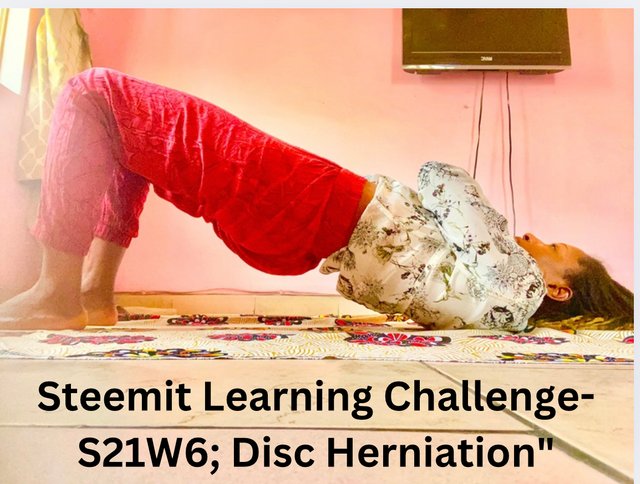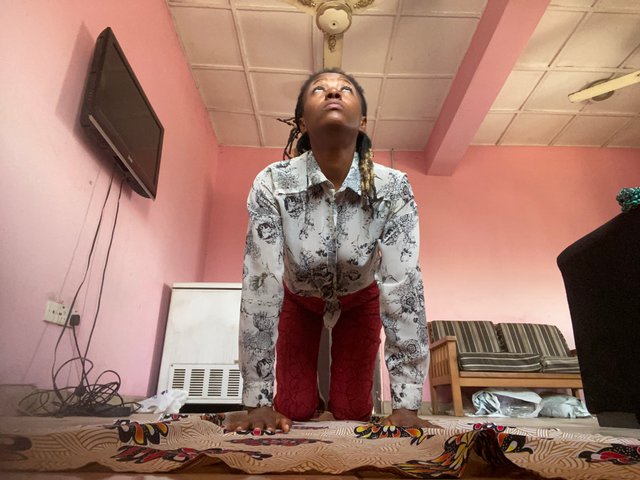Steemit Learning Challenge-S21W6; Disc Herniation"
Greetings and welcome to my blog. Thanks for another week of beautiful exposition. Have learnt a lot during these weeks. Find below my assignment.

What's disc herniation? Write in your own words after getting knowledge from the lesson post. |
|---|
Disc heniation is a condition that occurs when there is a wear and tear in the soft gel like structure that is in the center of the spinal disc. The disc contains nucleus pulposus and annulus fibrosis and When this wear and tear occurs, the gel structure (nucleus pulposus) bulges out leading to to a reduction in the disc space and hence causes further wear and tear to occur. This is also called slipped disc.
When this occurs, the surrounding structures like the ligaments, nerves, tendons and muscles are also compressed especially the sciatic nerve. This condition is mostly seen in elderly people where wear and tear associated with age happens. Then people who live sedentary life styles may also be victims when they start doing excessive work at their old age that puts the discs under pressure and also keeping wrong postures when trying to lift up heavy weights or pick up item amongst others causes can be responsible for slipped disc.
Types of disc herniation
Slipped discs are classified into three type’s depending on the level of the disc region where it occurred. They includes;
Thoracic disc herniation: This is the disc herniation involving the T1-T12 disc of the upper back or thoracic region
Cervical disc herniation: This involves the C1-C7 vertebrae. This type of herniation is age related, the wear and tear occurs in the cervical region.
Lumber disc herniation: This involves the L1-L5 disc and it happens usually in the lower back region or the lumber region.
Symptoms of disc herniation
Patients with disc herniation show some symptoms and they include;
- Pain in the lower region of the back or the lumber region
- Pain in the cervical region such as neck, arm if it involves the cervical disc.
- Pain in the path of the sciatic nerve usually from the button legs, thighs and even the foot in extreme cases. (Sciatica)
- Feeling of weakness in the upper part of the body like the neck, arms and lower body parts like legs and thighs
- Tingling sensation and numbness due to the compression of the nerve.
How would you diagnose a disc herniation? Any clinical investigation or assessment tests? |
|---|
Diagnosis for disc herniation
There are different method that are used for disc herniation diagnosis and the commonest are;
X-ray: X-ray test imaging are used to check if there is reduction in the disc space and also to assess bone overgrowth.
MRI: MRI test is carried out to check if the muscles or the ligaments are affected and also to see if there is any compression of the nerves due to the slipped disc.
Physical examinations and also the family and medical history of the patient is taking into congnizance.
Special assessment tests for disc hieniation.
Some assessment tests can be carried out to confirm disc herniation and the type of test depend on the region of the slipped disc.
For the thoracic region, the schobers test which is used to access limitations and the flexion of the thoracic is used. Also the rotation test and the thoracic spine extension test which is used to access rotation, provoke pain and assess the pain in the thoracic region is used.
For the cervical region, a couple of tests comes into use such as the cervical rotation, cervical flexion test, Spurling tests, extension test, cervical compression test and the apprehension test is used.
For the lumbar region, tests like the extension test, straight leg raise, lumbar flexion, valsava test and the femoral nerve stretch comes into use.
Try to practice at least 3 exercises that you have learned from the lesson. Share images, gifs or videos while practicing preferably gifs or videos. |
|---|
Hip Bridging Exercise

This is carried out by lying on my back and bringing my knees backwards halfway in a bent position. I push up my hips while resting on my back and arms across my chest. This excercise helps to strengthen the muscles of the back since after the herniation, the muscle of the back region become stiff hence this strengthening exercise.
William Flexion (Knee to chest stretch)

Lie on my back and bring one of my knees forward toward my chest in a bend position while the other leg is stretched out on the floor. I wrap my fingers around the bent knee and pull towards my chest. This helps to strengthen the muscles of the hamstring and also improve ROM, and the pain in the back region by stretching the muscles that are below the back of the thigh.
Cat & Cow Stretch Exercise


I Put my arms and legs bent in a kneeling position and pull my back inwards and then go the opposite way by pulling by back inwards and my neck outwards. This helps to improves ROM, posture, balance , flexibility, strength, relaxation and stress, and also reduces stiffness. It improves back pain.
It’s advisable to apply heat pad on the area exercised for about five to ten minutes after the excercise.
Share your review after performing these exercises either on yourself, healthy individual or patient. |
|---|
The exercise impacted my spinal region and the was pressure on my spine and neck but I felt relieved of the muscles in those region as if there was warm sensations over my spine and it was relaxing.
Thank you for reading through. I ask @ruthjoe, @kizbooy and @ngozi996 to participate in this learning challenge.
Well done friend, you have explained well and in accordance with the material discussed that is about herniated discs. I also salute that you have really practiced the 3 exercises well. Nothing but to pray Good luck to you. Good luck friend.
Well said. Thanks for visiting my blog friend.
0.00 SBD,
0.00 STEEM,
0.01 SP
You're welcome, friend
Thank you for understanding the lesson and sharing your assignment; I hope that you will enjoy this week's lesson and try to implement it in your life if you see any such case.
Observations
Task 1 (3/3)
You have shared a great knowledge about disc herniation, its symptoms, and and causes, and its types. I appreciate your effort.
Task 2 (2.7/3)
In the second question, you tell us about how you have to assess a patient by doing physical examination and history taking, performing investigations and special tests. It would be better if you add explanation of one special test of each region to assess the disc herniation. Great.
Task 3 (4/4)
You try the hip bridging, William Flexion and cat & cow stretch exercises . You did the hip bridging, William Flexion and cat & cow stretch correctly. Always remember to apply heat pack before performing exercises to relax the muscles and reduce stiffness. I appreciate your efforts.
Overall you made a great attempt to answer all the questions. I appreciate your efforts. But next time try to avoid the above written suggestions. Keep learning and try to implement your knowledge to the people suffering from disc herniation or any type of back pain. Thank you.
Your post is very informative and nicely presented. Such an informative post about disc herniation is really appreciated. Thanks for sharing. Good luck for the contest.